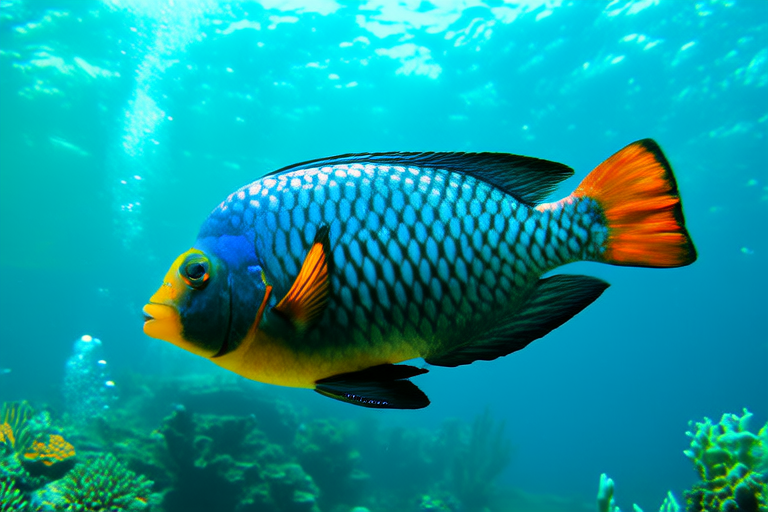The Colorful Journey: Exploring the Life of a Wild Parrot Fish
In the vast, mysterious ocean, few creatures captivate the imagination like the parrot fish. With their striking colors and intriguing behaviors, these marine denizens offer a window into the rich diversity of underwater life. This article embarks on a journey through the life of a wild parrot fish, delving into its vibrant life cycle, unique behaviors, and stunning color variations. We will also explore their role in marine ecosystems, the challenges they face in the wild, and the conservation efforts aimed at protecting them.
Introduction to Parrot Fish
Parrot fish are members of the family Scaridae, a group of around 90 species found primarily in tropical and subtropical waters worldwide. These fish are known for their large, beak-like mouths, which give them their name. Their most striking feature, however, is their dazzling array of colors, ranging from brilliant blues and greens to vibrant reds and yellows. The parrot fish’s vivid hues serve multiple purposes, from camouflage and mating displays to warding off predators.
Vibrant Life Cycle
The life cycle of a parrot fish begins with eggs, often laid in large quantities during spawning events. After hatching, the tiny fry drift in the open ocean, where they are part of the plankton community. As they grow, they develop distinct juvenile color patterns that differ from their adult counterparts. Juvenile parrot fish typically exhibit more subdued tones, allowing them to blend into their surroundings and avoid detection by larger predators.
As they mature, parrot fish undergo a dramatic transformation known as metamorphosis. This process involves changes in body structure, teeth formation, and, most notably, a shift in coloration. Adult parrot fish display the vibrant colors for which they are renowned, signaling their readiness to establish territories and attract mates. Throughout their lives, these fish continue to change, adapting to different stages and environments within the coral reef ecosystem.
Unique Behaviors
One of the most fascinating aspects of parrot fish behavior is their feeding habits. Using their powerful beaks, they scrape algae from coral reefs, contributing significantly to reef health. This activity not only provides sustenance but also helps maintain the delicate balance of the ecosystem by preventing algal overgrowth. Additionally, parrot fish have a peculiar sleeping habit: they secrete a mucous cocoon each night, thought to mask their scent from potential predators.
Parrot fish are also highly social creatures, often schooling together for protection against larger predators. Within these schools, complex hierarchies exist, with dominant males defending territories and attracting females. Male parrot fish can also change sex, a phenomenon known as protogynous hermaphroditism, where they start life as females before transitioning to males under certain conditions.
Stunning Color Variations
The color palette of parrot fish is nothing short of spectacular, with each species displaying a unique combination of hues. For instance, the queen parrot fish boasts a striking combination of electric blue and emerald green, while the midnight parrot fish features deep purples and blacks. These colors are not just aesthetically pleasing; they play crucial roles in communication and survival. During courtship, males often intensify their colors to impress potential mates, while territorial disputes may involve displays of aggression marked by vivid color changes.
Role in Marine Ecosystems
Parrot fish are vital contributors to marine ecosystems, particularly coral reefs. By consuming algae, they help prevent overgrowth, which could otherwise smother corals and disrupt the reef’s delicate balance. Additionally, their excreted waste acts as a source of nutrients for other organisms, supporting the overall health and productivity of the reef environment. Their presence also influences the composition of the reef itself, as their feeding activities can lead to the production of sand through the digestion and excretion of coral skeletons.
Challenges in the Wild
Despite their importance, parrot fish face numerous threats in the wild. Overfishing poses one of the greatest dangers, as their bright colors make them attractive targets for commercial fishing operations. Habitat destruction, caused by coastal development and climate change, further exacerbates their vulnerability. Rising sea temperatures and ocean acidification can harm coral reefs, reducing the available habitat for parrot fish and diminishing their food sources.
Pollution is another significant threat, with plastics and chemicals entering the ocean and potentially harming parrot fish directly or indirectly by altering their habitats. Moreover, the illegal trade in live parrot fish for aquariums depletes wild populations and disrupts local ecosystems.
Conservation Efforts
To address these challenges, various conservation initiatives have been implemented. Marine protected areas (MPAs) are established to safeguard critical habitats and allow parrot fish populations to recover. These protected zones restrict fishing and other human activities, providing a safe haven for marine life. Educational campaigns aim to raise awareness about the importance of parrot fish and the need for sustainable practices.
Research efforts focus on understanding parrot fish ecology and behavior better, informing conservation strategies. Scientists study population dynamics, genetic diversity, and the impact of environmental changes on parrot fish communities. Collaboration between governments, NGOs, and local communities is essential for effective conservation, ensuring that efforts are tailored to specific regions and ecosystems.
Conclusion
The colorful journey of a wild parrot fish is a testament to the wonders of marine life. From their vibrant life cycles and unique behaviors to their stunning color variations, these fish offer a glimpse into the intricate web of life in our oceans. Understanding their role in marine ecosystems and the challenges they face is crucial for their conservation. By supporting conservation efforts and promoting sustainable practices, we can ensure the continued existence of these remarkable creatures and preserve the beauty and biodiversity of our oceans for future generations.
